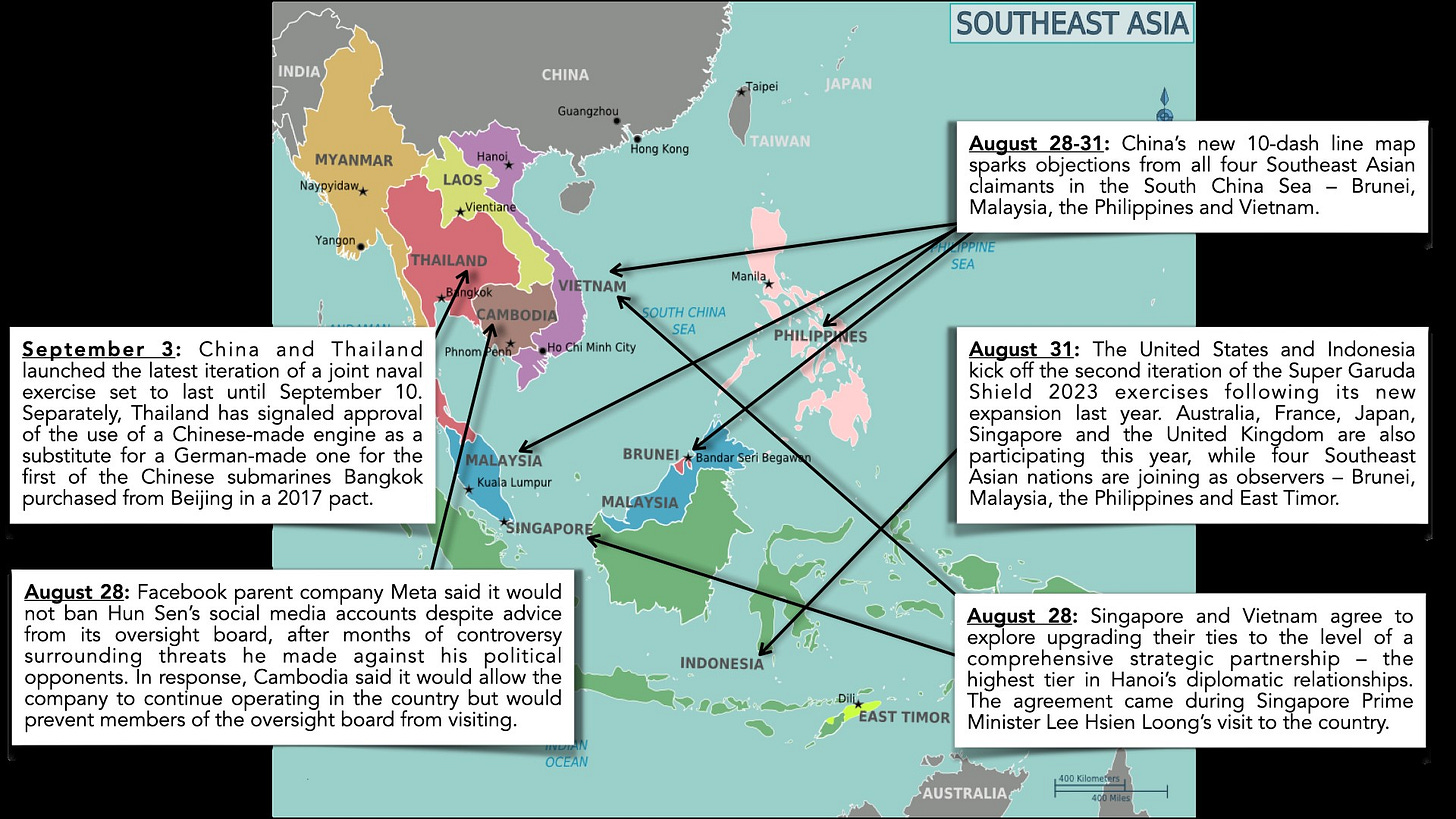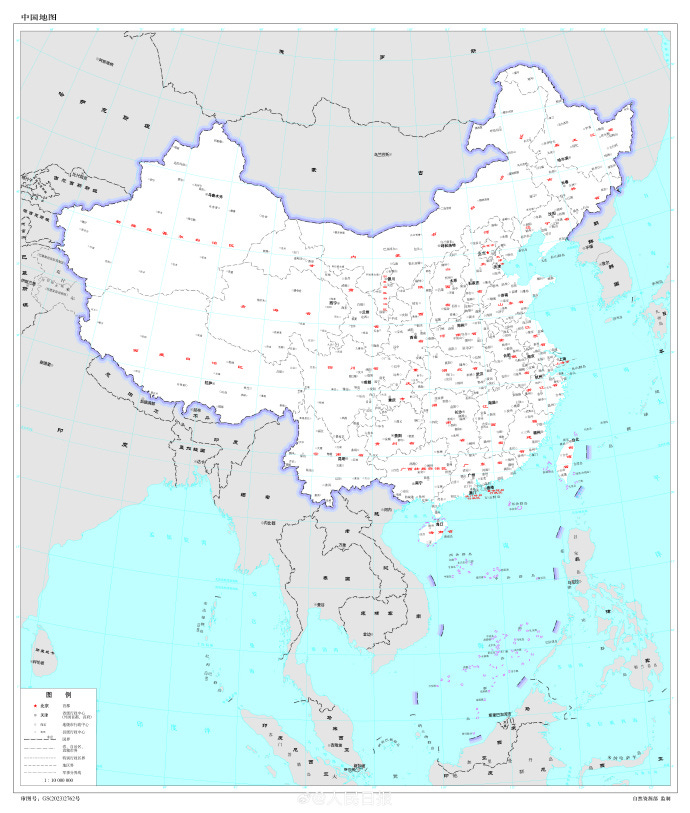Rare South China Sea Pushback on Display with New China South China Sea Map Response
Plus expanded Garuda Shield military drills; artificial intelligence development; the next major Vietnam economic pact and much more.
Greetings to new readers and welcome all to this edition of the weekly ASEAN Wonk BulletBrief! For this iteration, we are looking at:
Assessing the implications of pushback in Southeast Asia and beyond against China’s new map;
Mapping of regional developments including the expanded U.S.-Indonesia Super Garuda Shield exercise; new China-Thailand drills; a coming Singapore-Vietnam relations upgrade and more;
Charting evolving trends such as on artificial intelligence development in Southeast Asia and the growing role of social media in political mobilization in the Philippines;
Tracking and analysis of industry developments including the next major Vietnam economic pact; intra-ASEAN critical mineral dynamics; a rare deeper dive into Cambodian public opinion and more;
And much more! ICMYI, check out our review of a new book on a multipolar future for Southeast Asia, going beyond bipolar notions of a “new Cold War.”
WonkCount: 1746 words (~8 minutes reading time)
Expanded Super Garuda Shield Drills; Elevating Vietnam-Singapore Relations; China-Thailand Submarine Update & More

Rare South China Sea Unity on Display with New China South China Sea Map Response
China’s publishing of a new South China Sea map has sparked a rare series of quick coordinated statements among claimant states and interested parties after a strikingly assertive month in Beijing’s approach and just ahead of upcoming regional summitry1.
What’s Behind It
China’s publishing of a new national map saw coordinated rejections from claimant states and other interested parties. Within Southeast Asia, the rejections came from five of the ten ASEAN countries with the most interest in the South China Sea issue — Brunei, Indonesia, Malaysia, the Philippines and Vietnam. Yet others such as India and Taiwan also issued statements in response to the map as well given implications on their interests as well as potential crossover impacts into Southeast Asia and the wider Indo-Pacific region.
The map is just the latest in a series of moves by Beijing to strengthen the legitimacy of its claims. China has published maps of this kind on an annual basis for since the mid-2000s, and it also began a designated week and day to promote national awareness of these maps a few years ago. In the month of August alone, in addition to this latest iteration of its map, China has also taken coercive actions like firing water cannons on vessels and fishermen of the Philippines and Vietnam. Beijing also continues to incrementally build up its capabilities on South China Sea features after spending the past decade or so militarizing several manmade islands, with the latest feature in the headlines being Triton Island in the Paracels as noted previously in these pages (see table below).
Select Recent Major South China Events in August
Why It Matters
It is rare to see such a series of quick coordinated statements among Southeast Asian states, with five countries issuing statements in the span of just four days. While the Philippines and Vietnam have generally been the two more vocal South China Sea claimants in Southeast Asia, Malaysia, which has seen the issue be in the spotlight a few times already during Prime Minister Anwar Ibrahim’s first year in office, was the first to issue a response. Even Brunei, whose responses to China are often the quietest and the hardest to detect publicly among the four Southeast Asian claimant states, issued a statement of its own2.
Select Excerpts of Southeast Asian Responses to China’s New Map

Strategically, the pushback against China’s actions like we saw this week is a critical component of blunting Beijing’s efforts to legitimize its claims, even if it is partial and uneven. Policymakers know that silence on actions like new maps only plays into China’s hope that its growing capabilities and assertive moves will create a numbing effect such that it eventually achieves effective control of the South China Sea both on paper and on the water at the expense of other claimant states. That said, the differences in the statements themselves did reinforce the variances in approaches between these countries. Similar unity has also typically proven more elusive when it comes to China’s aggressive actions on the water targeted at individual claimant states, such as the use of blinding lasers or water cannons. This is made more difficult by Beijing’s own efforts to divide claimant states through a mix of coercive and collaborative endeavors.
Where It’s Headed
The map controversy all but assures that the South China Sea will be potentially even more of a key issue at the upcoming round of ASEAN summitry led by chair Indonesia, and even at the G-20 meetings led by India in 2023. Indonesia had sought to prioritize maritime issues during its chairmanship through various initiatives including keeping the South China Sea code of conduct talks alive, organizing regional drills and publishing the ASEAN Maritime Outlook3. The Philippines has also been pushing for a stronger and more coordinated ASEAN response on the South China Sea given the growing pressure it faces4. Nonetheless, within ASEAN, any collective response would also need to take into account the views of the typically not-so-interested Southeast Asian states on the South China Sea question.
The more important question looking ahead is whether the coordinated pushback in words will also be accompanied by more actions to address the vast asymmetry in military capabilities in the South China Sea that remains massively in China’s favor. Previously, even modest ideas like a minilateral South China Sea claimants group have proven difficult to sustain, let alone more far-reaching balancing initiatives. It is true that claimant states are taking moves that may have been difficult to foresee just a few years ago, such as Vietnam’s coming upgrading of its ties with the United States, the expansion of Indonesia’s Garuda Shield exercises and the Philippines’ regular participation in minilateral security networking. Yet few would argue that these cumulative actions either match or outpace China’s South China Sea inroads or are likely to be sufficient to deter Beijing from undertaking future actions that change the status quo in its favor at the expense of others.
Artificial Intelligence Development; A Rights Approach to Countering Southeast Asia’s Giant Scams; Social Media and Mobilization in the Philippines
“It will be important for ASEAN to have a strategy that is not just symbolic in form,” notes a new commentary on artificial intelligence (AI) published by the ISEAS Yusof-Ishak Institute. The piece comes amid the grouping’s ongoing development of a new AI framework as previously noted in these pages. It includes an assessment of where Southeast Asian states are on AI thinking and components of an approach such as data protection, cybersecurity and consumer protection (see table below as an example) (link).
Snapshot of ASEAN Country Artificial Intelligence Frameworks
“A human-rights based approach to this complex situation means not merely addressing organized crime or enforcing border controls, but seeks to place victims at the center of the response,” notes a new report on Southeast Asia’s giant Mekong scams published by the United Nations. The report details seven aspects of a human rights response, including an adequate legal framework, rights-based governance of migration as well as cooperation and coordination (link).
Graphic Depicting Select Scam Center Locations in Southeast Asia
“[S]ocial media will no longer be viewed as a supplement but an indispensable part of any viable and winnable electoral campaign in future electoral cycles,” notes a new article on social media youth engagement in the 2022 Philippine elections as part of a new multi-country issue by Kyoto Review of Southeast Asia. The article documents the two-pronged role of social media in both mobilizing and polarizing the country, with statistics including on the levels of engagement of voters who supported Ferdinand Marcos Jr (see table below) (link).













